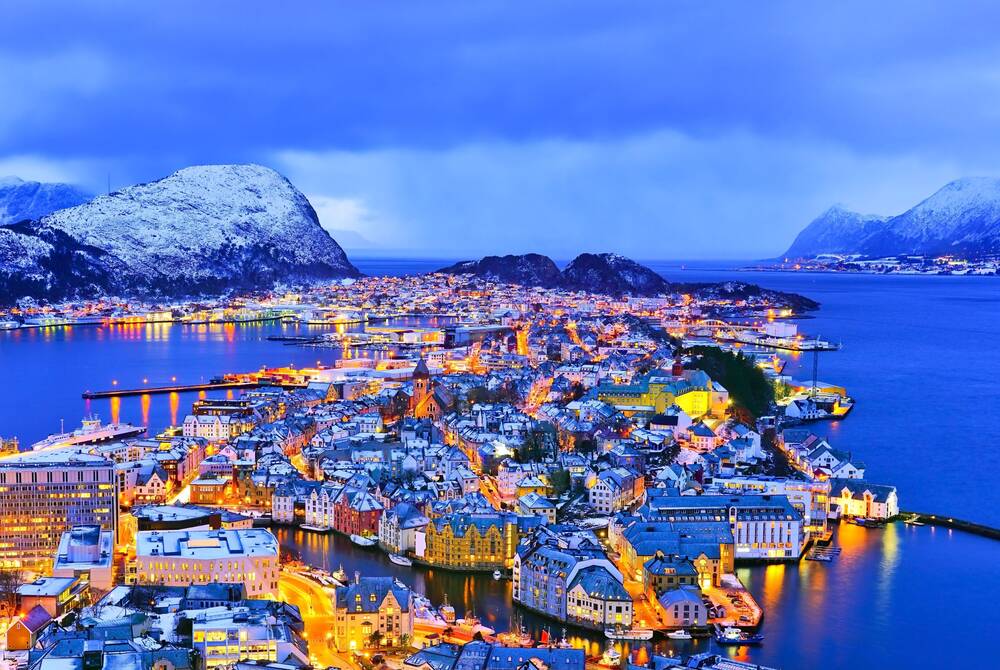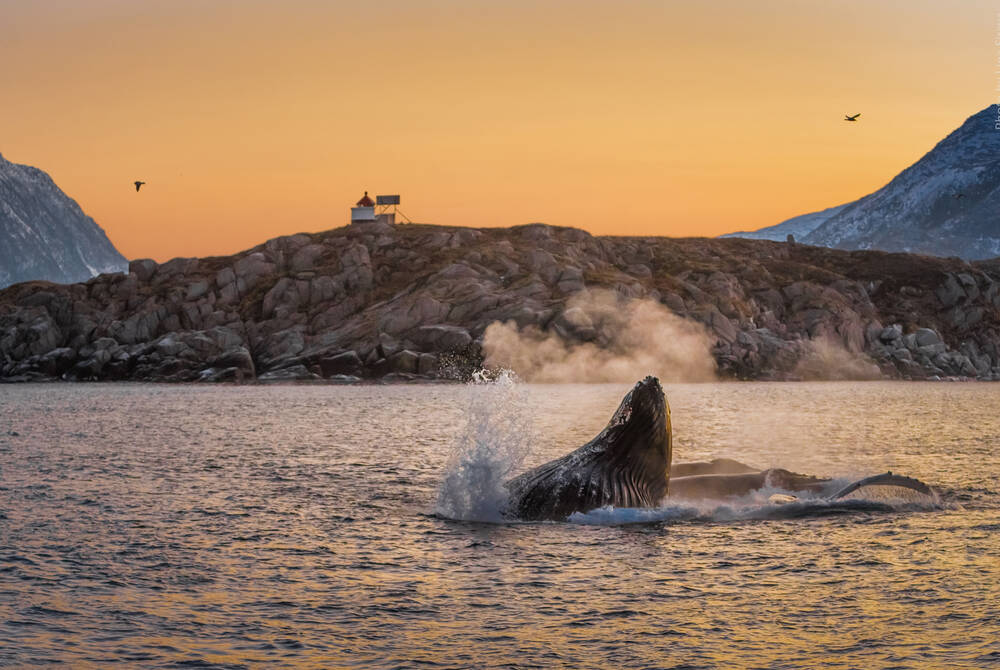It’s just as well that we didn’t know we were about to snowmobile over the longest route provided at this time of year, or that it was at least ten degrees Celsius colder than the previous day (which had been an inhospitable -16, according to Charlotte, our guide – as an aside, when a native of Svalbard is stamping her feet to get warm, you should probably assume you’re in trouble). It was probably better not to know the exact location or size of the ice sheet we would pass over, though the flipped snowmobile gave away the secret in the end. It was definitely just as well that half our group didn’t realise we would be eating lunch outdoors, rather than in some cosy basecamp, stretching our time outside to more than five hours.
All of which is to say, as with most slightly scary new adventures, it can be best to just dive in.

Eleven of our 14-person group had never ridden a snowmobile before, and the briefing in the Hurtigruten Svalbard office was a not-quite-kidding series of jokes about getting pulled over or trying to outrace polar bears (of which there are more than humans, and yes, they do pop up to say hello occasionally). Charlie and Mads sat on the demo scooter, showing the controls and joking about the lack of toilets (which I advise taking rather seriously), and by the time we were setting off in the noonday dark, it was easy to convince ourselves that we were in fact the least-prepared group of humans on the planet, destined to either panic and weep our way back to base after half an hour, or go completely feral and never be heard from again.

I, for one, made a complete fool of myself within the first twenty seconds, with a jerky stop-and-go that made turning completely impossible… especially because, in my eagerness to prove myself a good student and not a careless tourist, I had pulled my helmet visor so low over my face that it was immediately and completely shrouded in the neurotic fog of my breath.
Meanwhile, the two drivers directly in front of me in our duckling parade were simultaneously and merrily crashing into one another. We were doomed.
That is, until we made our way into the open crossing of Adventdalen (Advent Valley, named not for the period before Christmas, but the Norwegian difficulty in pronouncing its original English name, ‘Adventure Valley’). Here, our adrenaline-pumped limbs that had spent the last 24 hours cramped in various planes, trains and unfamiliar hotel rooms finally found cold, fresh air, space and quiet.
"We left the light of Longyearbyen behind us and slipped into each other’s ski tracks with rumbling, growling jerks and starts. I for one distinctly remember catching sight of my speedometer as it clicked to 50 kilometres per hour."
The blue twilight was beginning to rise, and whereas in the town lights it had seemed black overhead, now we could see it lifting towards navy, and an embarrassment of stars had been thrown across the silken sky. We paused to fling some feeling back into our limbs and get instructions from our guides – get above 20 kilometres an hour, 30 is best if you want to be able to turn the heavy machinery without throwing your bodyweight off-balance – and they pointed out the three electrically-lit coal mines that seemed little more than cottages from where we stood. It seemed utter wilderness.
Until five minutes later, as we, naively confident in our half-hour-old expertise in snowmobile driving, took off again into the dark. We left the light of Longyearbyen behind us (which in each of our hometowns would barely register as a blip in the sky but out here bled into the heavens for days around) and slipped into each other’s ski tracks with rumbling, growling jerks and starts, and I for one distinctly remember catching sight of my speedometer as it clicked to 50 kilometres per hour.

After who knows how long (and really, aren’t the best holidays the ones where you lose track of time and space entirely?), all the scooters in front of me began to slow and stop, until we realised our compatriot was sideways on the ground. Obediently, we all stopped in a huddle (snowmobiles are alarmingly quick to accelerate but also reassuringly quick to slow down). The mountains loomed in all directions, vague and menacing in the gloom, and the feeling was one of swimming in opaque water – there might be something right alongside you, but you would never know.
This was wilderness, this glacial patch in the midst of ancient giants. This was isolation. This was danger, for without a guide or functioning GPS (and make no mistake, the cold is too strong this time of year for traditional mobiles and cameras to function at all) you could easily get turned around and disappear into the silence.
"The trip played with your sense of distance – Longyearbyen seemed to always be just over the next crest – as well as time, leaving the mind, still overly confident, free to wander. At least, that is, until the body and better sense kicked in to shriek, ‘Focus! No one cares about which thermals you’re wearing tomorrow, DRIVE!’"
This was, most of all, cold. From a cold climate myself, I’m used to being somewhat macho about winter – fortunately, I was also taught to respect it. Growing up with school closing on days cold enough for frostbite to set within ten minutes, I thought I knew cold.
Haha.
Attempts at photography failed, because before I could even discover the frozen camera shutter, I first discovered that removing my mittens (supplied, alongside a full snowsuit, boots, balaclava and helmet as part of my Hurtigruten kit) left my fingers completely and painfully numb – fiddling with zippers was not only futile, it became dangerous as a laceration would go completely unnoticed.

Over the next hour or so we got more comfortable on our snowmobiles, tackling bumps and even minor hills and narrow, winding canyons with, if not ease, enthusiasm. Lunch turned out to be a pit stop of freeze-dried food packets heated with boiling water carried by our guides, which was truly delicious to each and every participant (though eating in a full balaclava and mittens meant a LOT of chilli con carne dropped on your clothes… ah well. It would freeze a moment later).
The ride back to civilisation – and that is no hyperbole, the settlement of Longyearbyen began to loom in our imaginations as a cosmopolitan oasis rather than the 2,500-strong hamlet it is – was one of simultaneous awe, adrenaline, and challenge. Limbs grew stiff and quicker to chill after hours on the machines, and the blue twilight, so lovely and velvet, slipped back to a deep darkness until all your field of vision took in was the yellow headlights of the driver in front of you. The trip played with your sense of distance – Longyearbyen seemed to always be just over the next crest – as well as time, leaving the mind, still overly confident, free to wander. At least, that is, until the body and better sense kicked in to shriek, ‘Focus! No one cares about which thermals you’re wearing tomorrow, DRIVE!’
And simultaneously, ‘STOP.’ As in, stop thinking at all, stop planning and ruminating and fantasising and worrying, and enjoy that for this moment, you are one of a handful of people on the edge of the world. You are one of the few, the lucky. You are tougher than you were this morning, and colder than you ever hope to be again.
You are capable, and healthy, and here.


